 W
WThis is a list of the mammal species recorded in Bangladesh. There are eighty-nine mammal species in Bangladesh, of which three are critically endangered, twelve are endangered, sixteen are vulnerable, and four are near threatened.
 W
WThis is a list of the mammal species recorded in Bhutan. There are ninety mammal species in Bhutan, of which one is critically endangered, ten are endangered, fourteen are vulnerable, and three are near threatened.
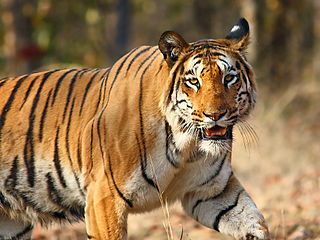 W
WThis list of mammals of India comprises all the mammal species alive in India today. Some of them are common to the point of being considered vermin while others are exceedingly rare. Many species are known from just a few zoological specimens in museums collected in the 19th and 20th centuries. Many of the carnivores and larger mammals are restricted in their distribution to forests in protected areas, while others live within cities in the close proximity of humans. They range in size from the Eurasian pygmy shrew to the Asian elephant. They include nocturnal small mammals endemic to India such as the Malabar large-spotted civet. While the status of many of these species is unknown, some are definitely extinct. Populations of many carnivores are threatened. The tiger, dhole, and Malabar large-spotted civet are some of the most endangered carnivore species. Two rhinoceros species are extinct within the Indian region, but the remaining species has its last stronghold within India. The Asiatic cheetah was extirpated in India in the 1950s.
 W
WThe honey badger, also known as the ratel, is a mammal widely distributed in Africa, Southwest Asia, and the Indian subcontinent. Because of its wide range and occurrence in a variety of habitats, it is listed as Least Concern on the IUCN Red List.
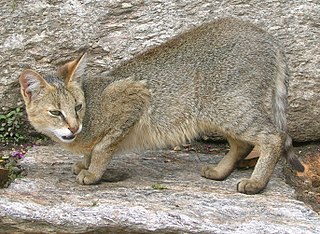 W
WThe jungle cat, also called reed cat and swamp cat, is a medium-sized cat native to the Middle East, South and Southeast Asia and southern China. It inhabits foremost wetlands like swamps, littoral and riparian areas with dense vegetation. It is listed as Least Concern on the IUCN Red List, and is mainly threatened by destruction of wetlands, trapping and poisoning.
 W
WThe Asian palm civet is a viverrid native to South and Southeast Asia. Since 2008, it is IUCN Red Listed as Least Concern as it accommodates to a broad range of habitats. It is widely distributed with large populations that in 2008 were thought unlikely to be declining. In Indonesia, it is threatened by poaching and illegal wildlife trade; buyers use it for the increasing production of kopi luwak, a form of coffee that involves ingestion and excretion of the beans by the animal.
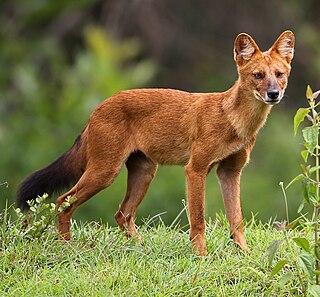 W
WThe dhole is a canid native to Central, South, East, and Southeast Asia. Other English names for the species include Asian wild dog, Asiatic wild dog, Indian wild dog, whistling dog, red dog, and mountain wolf. It is genetically close to species within the genus Canis, but distinct in several anatomical aspects: its skull is convex rather than concave in profile, it lacks a third lower molar and the upper molars sport only a single cusp as opposed to between two and four. During the Pleistocene, the dhole ranged throughout Asia, Europe, and North America but became restricted to its historical range 12,000–18,000 years ago.
 W
WEld's deer, also known as the thamin or brow-antlered deer, is an endangered species of deer endemic to South Asia. The species was first described and given its binomial name from specimens obtained in Manipur in India in 1839. The Manipur name for the deer was noted as Sungnaee and it was described in 1842 by John McClelland as being "nondescript" but it was given the name Cervus eldi by Guthrie. in honour of Lt. Percy Eld, a British officer who was attached to the residency at Manipur. The three subspecies of the Eld's deer are:Panolia eldii eldi: The Manipuri brow-antlered deer is found in Manipur, India. It is called sangai in Meitei. P. e. thamin: The Burmese brow-antlered deer found in Myanmar, and westernmost Thailand. P. e. siamensis: The Thai brow-antlered deer is found in Cambodia, China, Laos, Thailand and Vietnam, and should perhaps be treated as a separate species. The population on the Chinese island of Hainan is sometimes considered another subspecies, P. e. hainanus, but this is not supported by genetic evidence. It was described by Lydekker in 1915.
 W
WThe dhole is a canid native to Central, South, East, and Southeast Asia. Other English names for the species include Asian wild dog, Asiatic wild dog, Indian wild dog, whistling dog, red dog, and mountain wolf. It is genetically close to species within the genus Canis, but distinct in several anatomical aspects: its skull is convex rather than concave in profile, it lacks a third lower molar and the upper molars sport only a single cusp as opposed to between two and four. During the Pleistocene, the dhole ranged throughout Asia, Europe, and North America but became restricted to its historical range 12,000–18,000 years ago.
 W
WThe fishing cat is a medium-sized wild cat of South and Southeast Asia. Since 2016, it is listed as Vulnerable on the IUCN Red List. Fishing cat populations are threatened by destruction of wetlands and have declined severely over the last decade. The fishing cat lives foremost in the vicinity of wetlands, along rivers, streams, oxbow lakes, in swamps, and mangroves.
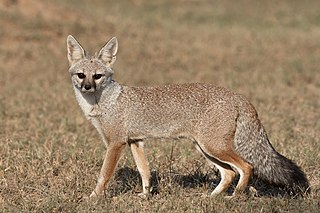 W
WThe Bengal fox, also known as the Indian fox, is a fox endemic to the Indian subcontinent from the Himalayan foothills and Terai of Nepal through southern India, and from southern and eastern Pakistan to eastern India and southeastern Bangladesh.
 W
WThe Indian hare, also known as the black-naped hare, is a common species of hare found on the Indian subcontinent, Nepal, Sri Lanka, and in Java. It has been introduced to Madagascar, Comoro Islands, Andaman Islands, Irian Jaya, Papua New Guinea, Seychelles, Mayotte, Mauritius and Réunion.
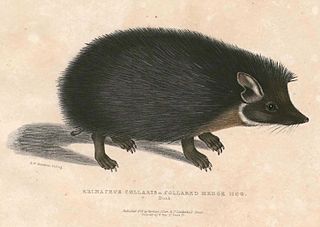 W
WThe Indian long-eared hedgehog is a small species of mammal native to northern India and Pakistan. It is insectivorous and nocturnal.
 W
WThe Indian wolf is a subspecies of grey wolf that ranges from Southwest Asia to the Indian Subcontinent. It is intermediate in size between the Himalayan wolf and the Arabian wolf, and lacks the former's luxuriant winter coat due to it living in warmer conditions. Within this subspecies, the "Indian plains wolf" is genetically basal to all other extant Canis lupus apart from the older-lineage Himalayan wolf, with both proposed as separate species. The Indian wolf travels in smaller packs and is less vocal than other variants of the grey wolf, and has a reputation for being cunning.
 W
WThe golden jackal is a wolf-like canid that is native to Southeast Europe, Southwest Asia, South Asia, and regions of Southeast Asia. Compared with the Arabian wolf, which is the smallest of the gray wolves, the jackal is smaller and possesses shorter legs, a shorter tail, a more elongated torso, a less-prominent forehead, and a narrower and more pointed muzzle. The golden jackal's coat can vary in color from a pale creamy yellow in summer to a dark tawny beige in winter. It is listed as 'least concern' on the IUCN Red List due to its widespread distribution and high density in areas with plenty of available food and optimum shelter.
 W
WJafarabadi buffalo is a riverine buffalo that originated in Gujarat, India. It is estimated that there are about 25,000 Jafarabadi buffaloes in the world. It is one of the important buffalo breeds of India and Pakistan. The Jafarabadi buffalo is also the first buffalo breed exported to Brazil, and is also one of the four buffalo breeds raised in Brazil as of 2017, the others being Mediterranean, Murrah and swamp buffalo.
 W
WThis list of mammals of Nepal presents mammal species recorded in Nepal, of which one is critically endangered, eleven are endangered, twenty are vulnerable, and four are near threatened. The following tags are used to highlight each species' conservation status as assessed on the IUCN Red List:
 W
WThe Indian muntjac, also called the southern red muntjac and barking deer, is a deer species native to South and Southeast Asia. It is listed as Least Concern on the IUCN Red List.
 W
WThe smooth-coated otter is an otter species occurring in most of the Indian subcontinent and Southeast Asia, with a disjunct population in Iraq. It is listed as Vulnerable on the IUCN Red List since 1996 and is threatened by habitat loss, pollution of wetlands and poaching for the illegal wildlife trade. As its name indicates, its fur is smooth and shorter than that of other otter species.
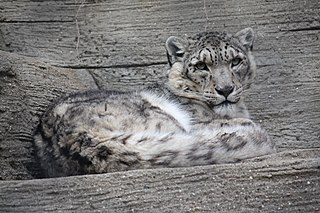 W
WThis list of the mammals of Pakistan shows the conservation status of the 173 mammal species occurring in Pakistan, of which 12 are critically endangered, 11 are endangered, 14 are vulnerable, and 10 are near threatened. The largest mammal in Pakistan is the Asiatic brown bear. Capra falconeri, the markhor, is the national animal of Pakistan. The following tags are used to highlight each species' conservation status as assessed on the IUCN Red List:
 W
WThe Indian crested porcupine is a hystricomorph rodent species native to southern Asia and the Middle East. It is listed as Least Concern on the IUCN Red List. It belongs to the Old World porcupine family, Hystricidae.
 W
WThe sambar is a large deer native to the Indian subcontinent, South China, and Southeast Asia that is listed as a vulnerable species on the IUCN Red List since 2008. Populations have declined substantially due to severe hunting, insurgency, and industrial exploitation of habitat.
 W
WThe Asian house shrew is a shrew species native to South and Southeast Asia that has been listed as Least Concern on the IUCN Red List since 2008 because of its large population and wide distribution. It has been introduced in several West Asian and East African countries. It is considered an invasive species and implicated in the demise of several island lizard species.
 W
WThe sloth bear is a myrmecophagous bear species native to the Indian subcontinent. It feeds on fruits, ants and termites. It is listed as Vulnerable on the IUCN Red List, mainly because of habitat loss and degradation.
 W
WThe small Indian civet is a civet native to South and Southeast Asia. It is listed as Least Concern on the IUCN Red List because of its widespread distribution, widespread habitat use and healthy populations living in agricultural and secondary landscapes of many range states.
 W
WThe Bengal tiger is a tiger from a specific population of the Panthera tigris tigris subspecies that is native to the Indian subcontinent. It is threatened by poaching, loss, and fragmentation of habitat, and was estimated at comprising fewer than 2,500 wild individuals by 2011. None of the Tiger Conservation Landscapes within its range is considered large enough to support an effective population of more than 250 adult individuals. India's tiger population was estimated at 1,706–1,909 individuals in 2010. By 2018, the population had increased to an estimated 2,603–3,346 individuals. Around 300–500 tigers are estimated in Bangladesh, 220–274 tigers in Nepal and 103 tigers in Bhutan.
 W
WThe water buffalo, also called domestic water buffalo or Asian water buffalo is a large bovid originating in the Indian subcontinent, Southeast Asia, and China. Today, it is also found in Europe, Australia, North America, South America and some African countries. Two extant types of water buffalo are recognized, based on morphological and behavioural criteria – the river buffalo of the Indian subcontinent and further west to the Balkans, Egypt, and Italy, and the swamp buffalo, found from Assam in the west through Southeast Asia to the Yangtze valley of China in the east.